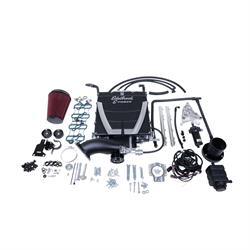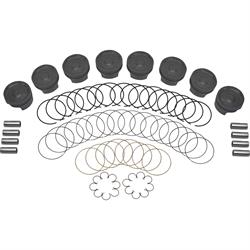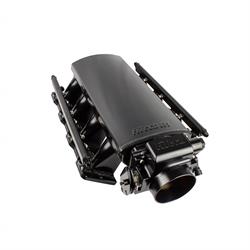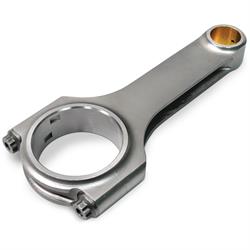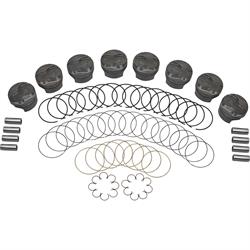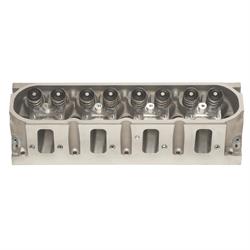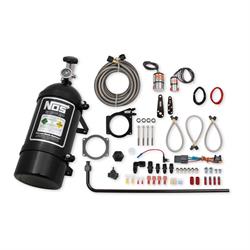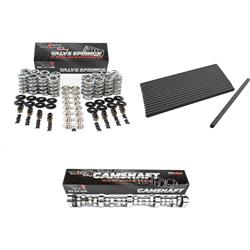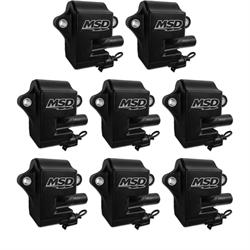5.7 LS1 Engine Upgrades: Build Recipes for 400 HP-700+ HP
How Much Horsepower Does a 5.7 LS1 Have | LS1 Stock Horsepower
In 1997 the small block Chevy we all knew and loved would change forever. Introduced in the 1997 Chevrolet Corvette, the all new Gen III 5.7-liter LS1 small block (technically 346ci) would only share its displacement, rough external dimensions (which is one of the main reasons they are so swap friendly), and its rod bearings with the outgoing Gen II 350 LT1 small block. Even the LS1 firing order is different (common to all LS engines). So, what is a LS1 engine? This clean sheet engine design using an aluminum block and cylinder heads, while the same displacement, grew the stroke and reduced the bore size. The Gen 1 and Gen II 350/5.7 bore and stroke were 4.00” x 3.48”, while the new LS1 used 3.898” x 3.622”. Interestingly enough, this first gen LS engine was not referred to as such by enthusiasts initially. The “LS” was in fact part of the regular production option (RPO) code “LS1” (and later the LS6) and became the de facto descriptor for Gen III and Gen IV small block Chevy V8s moving forward.
Besides the 1997-2004 Corvette, where the LS1 engine was rated at 345 hp (stock LS1 horsepower was 350 hp for 01-04 manual trans ‘Vettes), the LS1 can also be found between the front fenders of the 4th Gen F-body Firebird and Camaro from 1998-2002. The F-body 5.7 LS1 horsepower varied from 305-345 depending upon model year and trim level with the Camaro SS and Firebird WS6 models at the top of the LS1 engine hp hill. Additionally, the LS1 can be found in the 2001-2005 Holden Monaro in Australia, and the rebadged US import model that became the short lived 2004-2006 Pontiac GTO (the LS1 was only found in the 2004 model, as the 2005-2006 would be updated with the LS2). Note that in some swap instances the stock accessories may interfere with your vehicle’s frame or suspension. We offer a selection of LS1 accessory drive kit options to alleviate this problem. Learn more about dropping an LS1 into your ride with our LS swap guide elsewhere in the Toolbox.
LS1 vs LS6
While the LS1 was quite the departure from the Gen I and Gen II small block Chevy it replaced, it was just the beginning of the new LS engine family of varying displacements and features. New for 2001 was the LS6 engine. This LS is a higher output version of the LS1, making 385 to 405 horsepower depending upon the application and model year, yet the LS6 engine displacement remains the same as the LS1 at 5.7 liters. The LS6 was used in only two vehicles: the 2001-2004 Corvette Z06 and the 2004-2005 Cadillac CTS-V. GM upped the compression ratio, updated the cam profile with more duration and lift, and increased the engine’s breathing with revised intake, cylinder heads, and mass airflow meter, all providing an increase in LS6 horsepower. Durability was also improved with a revised cylinder block for increased main web strength, while sodium filled exhaust valves, and an updated engine oiling system were employed to combat heat related stresses and survive higher acceleration forces. The LS6 would be replaced by the 7.0L Gen IV LS7 in 2006.
LS1 400 HP Build Parts List
- COMP Cams K54-426-11 Xtreme Hydraulic Roller Camshaft Kit
- Performance Racing LS Series Trunnion Upgrade Kit
- Holley Sniper 90MM LS Throttle Body
- MSD Ignition Coil, GM LS Blaster Series, LS1/LS6, 8-Pack
- 8.5mm LS Spark Plug Wire Set, 180 Degree Boots, 12 Inch
- Fel-Pro Chevy LS Timing Cover Gaskets
- Chevrolet Performance Parts Harmonic Balancer Bolt
LS1 500 HP Build Parts List
- MAHLE 28cc Dish PowerPak Piston Kit, 4.005 Inch Bore
- Scat ProSport H-Beam LS Connecting Rods
- AFR LS1 210 Enforcer Heads, Cathedral Port, Assembled, 2 qty
- COMP Cams XFI XE-R Hydraulic Roller Camshaft Kit
- Stainless Steel Roller Rocker Arm, 1.7:1, 0.375 Inch, LS
- FiTech Loaded LS1 Aluminum Intake Manifold 500HP Kit, Black
- FiTech Go EFI External Fuel Pump Delivery Kit
- MSD Ignition Coil, GM LS Blaster Series, LS1/LS6, 8-Pack
- 8.5mm LS Spark Plug Wire Set, 180 Degree Boots, 12 Inch
- Universal LS Swap Radiator Kit w/ Steam Port Hose Adapter, Double Pass
- Fel-Pro Chevy LS Timing Cover Gaskets
- Chevrolet Performance Parts Harmonic Balancer Bolt
LS1 600 HP Build Parts List
- MAHLE LS 9.2cc Dome PowerPak Piston Kit, 4.005 In Bore
- Scat ProSport H-Beam LS Connecting Rods
- Scat 4340 Forged LS 4-Inch Stroke Crankshaft, 24x
- Brodix BP BR 3 LS3 Ported Cylinder Heads, 280cc
- LS1/2 N/A Stage 3 Camshaft, Titanium Valve Spring and Pushrod Kit
- Stainless Steel Roller Rocker Arm, LS, 1.8:1, 0.375 Inch
- FiTech LS1/LS2/LS3 Tall Aluminum Intake Manifold 750HP Kit
- FiTech Force Fuel System
- MSD Ignition Coil, Pro Power Series, GM LS1/LS6, 8-Pack
- MSD 8.5mm Spark Plug Wires Set, LS1, Super Conductor, Red
- Universal LS Swap Radiator Kit w/ Steam Port Hose Adapter, Double Pass
- Fel-Pro Chevy LS Timing Cover Gaskets
- Chevrolet Performance Parts Harmonic Balancer Bolt
How Much HP Can a 5.7 LS1 Handle
Like many production engines of the day, the cylinder block and rotating assembly are the performance limiters when discussing the theoretical maximum power output of 5.7 LS1 horsepower. In stock form, meaning stock block and rotating assembly, but otherwise anything bolted on is fair game (heads, camshaft, exhaust, etc.) the 5.7L LS1 can reliably produce 400 to 450 horsepower all day long. Torque output is maxed out in the same neighborhood of 400-450 ft-lbs. Depending upon the weight of the vehicle, that’s still a fun ride at those power levels. But if you’re wanting more the 5.7 LS1 can handle a surprising amount of power when properly prepped for a strong aftermarket rotating assembly (often bringing with it additional cubic displacement as well). When comparing Vortec vs. LS engines, the LS1’s aluminum block design offers weight savings over its iron-block Vortec counterparts, making it a favorite for performance builds. With the typical fully forged rotating assembly consisting of a crankshaft, rods, and pistons, a solid LS1 build can handle 600-700 horsepower and the same numbers for torque, making it perfect for a blower, turbo, or big nitrous kit with the proper tuning. Of course, you can always go straight to an LS1 crate engine versus piecing an LS1 hp build together for your 5.7 LS horsepower fix.
LS1 Turbo Kit VS LS1 Supercharger
As mentioned in the previous heading, getting those big power numbers not only takes strong internals, but the addition of a power adder like a supercharger or turbo. While these are lumped together under the power adder description, the turbo and the supercharger bring power to the table in different ways. At their basics, the turbo is spun by exhaust pressure to create boost, while the supercharger is spun by a belt driven off the crankshaft to create boost. Both options have their packaging issues, but you’ll find turbo systems are often more of a custom application, requiring fabrication of hot and cold side plumbing. Whereas the supercharger is most often packaged with a mounting bracket (centrifugal design) or replaces the intake manifold (roots and twin screw design) like the Edelbrock E-Force Supercharger LS for a much easier installation process.
Installation isn’t the only thing to consider here though, as turbo sizing affects power potential and where in the power band the power comes in. For superchargers it is somewhat the same in that the larger blower is capable of making more power, but you also have to consider pulley ratio for maximum boost without over-speeding the blower and the type of blower will also determine where the power band starts, as twin screw and roots style blowers are known for creating boost at lower rpm than the typical centrifugal. Turbos are generally known to be more efficient and capable of making more power overall than a similar supercharger offering, though at a bit higher rpm start. Either option will provide an ear-to-ear grin when you mat the go pedal and can easily make 500 or more horsepower with little effort with room to grow with more boost. Choosing which is best, a supercharger or a turbo, for your needs can be summed up as follows: You desire low-end torque and immediate power, choose the supercharger. Looking for high-end horsepower and efficiency, go turbo. Or even go twin turbo LS.
Turbo vs Supercharger Pros and Cons
Turbocharger:
- Pros: More efficient at higher rpm, potentially higher peak horsepower, better fuel efficiency under cruising conditions.
- Cons: Typically, more complex installation, potential turbo lag, requires careful tuning and cooling considerations.
Supercharger:
- Pros: Immediate power delivery, easier installation compared to turbos, reliable performance across a wide rpm range.
- Cons: Can be less efficient at higher rpm compared to turbos, adds weight to the engine.
LS1 Stroker Motor Build
Turbos and blowers are fun, but for many, reliable and low maintenance horsepower via increased displacement is often the preferred method to put more power to the pavement. A good old fashioned stroker engine build starting with an LS1 junkyard engine provides increased displacement, which provides more horsepower (and hey, you can always get crazy and add a turbo or supercharger to a stroker engine!). For the LS1 engine specs the maximum displacement most will see with a stock block casting is 383ci. That is a 4-inch stroke crank with 6.125-inch rods (what we’ve spec’d in our 600HP list above). You can find our full selection of LS stroker crankshafts and connecting rods to build the LS stroker of your dreams. For more detailed information on stroker engines, including benefits, installation tips, and tuning advice, refer to our What is a Stroker Engine guide elsewhere in the Toolbox.
Best LS1 Performance Parts
Like any production engine, there will be inherent weaknesses and limitations due to manufacturing, budget, and assembly constraints. Addressing these areas with aftermarket LS1 engine performance parts will not only increase your LS1’s performance but provide additional strengths and reliability into your LS1 build that will provide many years of trouble free driving. Key areas to improve on the LS1 include the valvetrain, cylinder heads, intake/exhaust, fuel system, cooling system, and more. You’ll note that many of these upgrades all have to do with increasing the airflow in and out of your built LS1. With additional airflow (and fuel to go with it) your LS1 upgrades not only will make more horsepower and torque but will have increased efficiency. While not a performance upgrade, with the age of these engines and their service life, we highly recommend a new LS1 starter be installed with any LS1 swap or build as well.
Intake and Exhaust Upgrades
Upgrading the LS engine intake can significantly improve airflow to the engine. Don’t forget a suitably sized throttle body and cold air inlet system as well. On the exit side of the LS1 a high-performance exhaust system, including LS shorty headers (or long tubes if you have the room/fitment) and a cat-back exhaust, will help reduce back pressure and allow for better exhaust flow, resulting in increased horsepower and torque.
Cylinder Head Upgrades
Upgrading your cylinder heads with improved/larger port designs found in aftermarket performance cylinder heads can increase airflow and combustion efficiency. This modification can yield significant power gains, especially when combined with a matching camshaft and intake manifold that will really allow significant airflow gains. We’ll break down several of these offerings further on down below.
Camshaft and Valve Train Upgrades
Replacing the stock camshaft with a more aggressive LS1 camshaft kit that includes matching valve springs, retainers, and more is one of the most effective ways to increase power. Along with the camshaft, upgrading valve springs, retainers, and pushrods in a matched kit like this ensures reliability and allows the engine to handle higher RPMs without valve float.
Fuel System Upgrades
With increased airflow through the engine the fuel system needs to be updated with higher flow fuel injectors and a high-performance fuel pump to provide the necessary fuel delivery for increased power levels you’ll see with your airflow upgrades.
Cooling System Upgrades
Upgrading the cooling system with a high-performance radiator and electric fans can help manage the additional heat generated by the performance upgrades we’ve mentioned above. Ensuring the engine operates at optimal temperatures not only protects the engine but optimizes efficiency. We offer application specific and universal LS swap radiators with and without electric cooling fan modules.
Forced Induction or Nitrous Upgrades
For a significant power boost, adding a supercharger or LS1 turbo kit kit forces more air into the engine, allowing for more fuel and increased power. Another option is using nitrous oxide, which injects nitrous into the intake manifold, adding oxygen for more fuel burn and a quick power increase. All these power adding options will require some sort of tuning, which leads us to our final upgrade mention.
Tuning and ECM Upgrades
Custom tuning is crucial to optimize the engine's performance after making modifications. A professional tune for your 5.7 LS build can adjust the air-fuel ratio, ignition timing, and other parameters to maximize power and efficiency. Upgrading the factory ECM or converting to an aftermarket stand-alone EFI system can provide additional control over engine settings and is paramount when exceeding factory tuning control with higher airflow, increased displacement, or using a power adder. Upgrading your engine management will allow you to take full advantage of your performance upgrades.
Best LS1 Heads
The stock LS1 heads feature a 2.00-inch intake/1.55-inch exhaust valve sizing, making them decent castings from GM to start. You can swap these cathedral port heads for other LS heads to increase or decrease chamber size to aid in compression needs or source other factory heads with larger valves (though most are not cathedral port and will require the proper intake). See our LS engines list for more details on head specs and casting number details.
When it comes to aftermarket aluminum heads for your 5.7 LS1 build you have a wide selection of cylinder heads to pick from that offer a wide range of features suitable for everything from large displacement NA builds to big boost and everything in between. These aftermarket heads improve airflow dramatically, which also brings with them efficiency and performance. Speedway Motors offers several brands that are a great fit for any LS engine build, including the LS1.
AFR (Air Flow Research) AFR heads are a popular choice for their excellent flow characteristics and build quality. The AFR 210cc heads are particularly well-regarded in the LS1 community for their performance gains.
Brodix Brodix offers LS heads like the LS3 and BR Series that are known for their high-flow capabilities and advanced porting, enhancing airflow, and supporting higher horsepower and torque in high-performance builds.
Edelbrock Edelbrock offers high-quality heads that are designed for street and strip applications. Their "E-CNC" series provides excellent flow and combustion efficiency.
Flo-Tek Flo-Tek LS heads are designed for excellent airflow and performance, with features like CNC porting and optimized chamber designs for improved combustion efficiency in both street and race applications.
Best LS1 Intake Manifold
The important thing to consider when upgrading an LS intake manifold is the port shape and bolt pattern. There are three main designs, the early cathedral port (stock on the LS1), and two rectangular port versions with standard with low mounting bolts and high port with centered mounting bolts. Your cylinder head intake port will determine what intake is compatible, so be aware swapping heads could also mean updating your intake manifold. While the Trailblazer SS (TBSS to enthusiasts) factory manifold does very well, as does the LS6 intake, they do have their limitations. An aftermarket intake manifold, coupled with a solid cold air induction system will really wake up an LS1 horsepower wise that has been upgraded with heads and cam. Note that for many LS1 swaps the stock throttle cable will not work, so a universal cable with a LS1 throttle cable bracket is the way to go here. Below are some solid LS intake manifold options that will help your LS1 breathe.
Comp Cams LSX RT Designed for high airflow and throttle response, suitable for high-performance builds requiring precise tuning.
LS Classic Combines modern performance with a vintage look, perfect for builds that need both style and performance with a retro ‘60s vibe for your LS swap.
FiTech Works with FiTech EFI systems to support high horsepower, making it excellent for EFI conversions and high horsepower applications.
MSD Atomic Airforce Engineered for high-performance and consistent airflow under high loads, ideal for racing and high-performance applications.
Holley/Holley Sniper Known for high-flow design and versatility, suitable for both street and race builds, often paired with Holley EFI systems.
Edelbrock Pro-Flo Offers excellent airflow and quality construction, compatible with various EFI systems, ideal for high-performance street and race applications.
Technical contributor: Jerad Flemming









